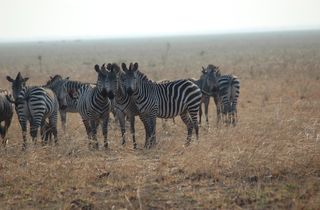The Real Reason Zebras Have Stripes

Zebra stripes, besides looking very cool, help to ward off biting flies, a new study finds.
The research, published in Nature Communications, negates the popular theory that zebra stripes evolved for camouflage against predators.
Photos: Animals Rescuing Animals
How did the camouflage theory originate in the first place then? Many animals do sport fur, skin, feathers and more that match their environments, making them more difficult to find.
Let's face it, though. Zebras stand out like fashion show supermodels against most any background.
Lead author Tim Caro of the University of California at Davis and colleagues, however, do mention that "humans find moving striped objects difficult to target accurately on a computer screen, suggesting a possible motion dazzle confusion effect."
A running zebra might then puzzle predators, but Caro and his team could find no consistent evidence for that after studying all seven existing wild equid species. (This group includes zebras, along with wild horses and wild asses.) Not all of these animals are striped. Przewalski's horse, for example, is usually solid brown in color.
Sign up for the Live Science daily newsletter now
Get the world’s most fascinating discoveries delivered straight to your inbox.
The researchers determined that the distribution of striped species overlaps with the ranges where biting flies are active. Zebras appear to be particularly sensitive to the flies.
"Biting fly mouth part lengths are markedly longer than average hair depths of zebras and approximately the same as zebra hair lengths, perhaps making zebras particularly susceptible to (biting fly) annoyance," the authors wrote.
Flies don't just irritate zebras either. The flies can spread disease and cause significant blood loss.
As for how the stripes ward off biting flies, the researchers explained, "Biting flies are attracted to hosts by odor, temperature, vision and movement that may act at different stages during host seeking, but vision is thought to be important in the landing response."
Lion Tries to Eat Baby in Zebra-striped Hoodie
The flies are attracted to dark colors, but stripes somehow seem to throw off the visual systems of the biting flies.
This likely isn't the last word on the function of zebra stripes, but if later investigations support it, there are a myriad of additional interesting possibilities. Could the stripes on other animals, such as house cats, also help to ward off biting insects? Could wearing certain striped clothing help people to prevent insect bites?
Most of us don't worry much about biting flies, but if stripes somehow confuse mosquitoes and other dangerous pests, expect to see a lot of striped shirts in future.
This story was provided by Discovery News.
